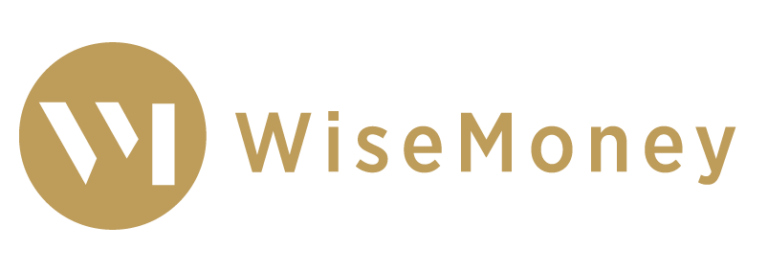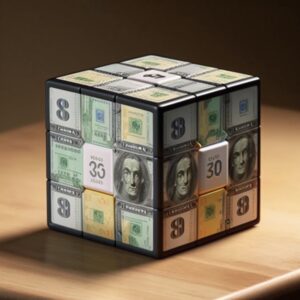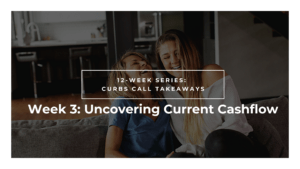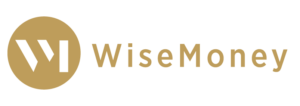Welcome to week 3 of CURBS. I’d love to share what my students learned this past week.
Although we touched on the subject last week, we went much deeper into the discussion (and understanding) of strategically managing money through a Profit & Loss (P&L).
Remember, as a business owner, your ultimate goal is not just revenue, it’s profit. Profit is what allows you to pay yourself. Without it, your hard work will be for nothing.
To determine how profitable your business is in any given period, you pull a P&L report. This report should show all of your sources of revenue and all of your categorized and itemized expenses. Your profit (or loss) is calculated by subtracting all of the costs and expenses from revenue. When you become serious about making profit, you’ll closely monitor all of the money flowing through your P&L.
It’s surprising how many business owners do not know their P&L numbers. On occasion, though, I do talk to the entrepreneur who is the exception. I congratulate them for their uncommon awareness and discipline in tightly managing their business finances.
However, when I ask these same business owners about the same numbers in their household finances, they often give me “a deer in the headlights look.” They are great at tracking the money in their business, but they do not bring the same discipline to their household finances. That means that they are in the same financial predicament as many others.
You see, it’s not just about managing your business finances well; you need to bring that same awareness and discipline to your household finances. When it comes to building wealth, household profit is just as important as business profit. Without it, your high income will be eaten up by high expenses, leaving you with no financial security or freedom. The key is to always make profit your number one financial intention – for not only your business, but also for your household. This is the secret to financial independence.
It looks something like this:
Business-owner Sally comes to me and says she is on the proverbial “hamster wheel,” working long, hard hours, but not getting ahead. Sally already admits to feeling burned out, but she is earning $180,000 per year, after taxes. Despite her high earning, Sally can’t figure out why she isn’t getting ahead.
Now, let me tell you why.
Like so many other people who come to me on the “hamster wheel,” Sally uses her entire income to cover the costs of her monthly lifestyle, leaving nothing extra.
Take a look at this spending breakdown.
Sally’s business makes $15,000 profit (after tax) in a month. She paid herself the $15,000 and deposited it into her household checking account.
In her CURBS Week 3 homework assignment, Sally organizes her income into categories of expenses on her household P&L.
The result is eye-opening to Sally!
Sally’s Household P&L
| Household Income | $15,000 | |
| Household Expenses | ||
| Mortgage PITI & HOA | $7,000 | |
| Cars Loan + Expenses (gas, insurance, tolls, car wash) | $1,500 | |
| Home costs (utilities, lawn, housekeeping, pool, maintenance) | $1,500 | |
| Groceries & Supplies (Target & Amazon) | $1,500 | |
| Kids Extracurricular Expenses | $500 | |
| Adults’ Extracurricular (gym, golf, hobbies..) | $300 | |
| Entertainment/Subscriptions | $500 | |
| Beauty, Salon, Nails, Botox, Spa, Massage | $500 | |
| Restaurants/Coffee | $800 | |
| Clothing/Shopping | $500 | |
| Medical | $250 | |
| Convenience Premium (door dash …) | $150 | |
| Total Household Expenses | $15,000 | |
| Profit | $0 |
Her household P&L reveals that Sally’s entire income is used to cover the costs of her monthly lifestyle, leaving nothing extra for savings or investments. In other words, there is nothing left for Sally’s future self. In CURBS, Sally has learned the importance of taking care of her future self financially. It wasn’t until she completed this exercise in CURBS, and those that led up to it, that she sees why she has no money to show for her hard work, no money for a family vacation or to remodel her kitchen, nor for her future self. This is why she feels the need to work even harder to pay for them, but can never afford them.
This is a prime example of “the hamster wheel” so many business owners find themselves on despite their high earnings. The household budget never turns a profit because every increase in income is accompanied by a natural increase in expenses. This leads to a mindset of postponing saving and investing until more money is earned – the wheel just keeps spinning but Sally stays in the same place, working harder and harder but never getting ahead.
Because of CURBS, Sally was able to gain a bird’s eye view of her finances by itemizing and categorizing her expenses through a simple household P&L. CURBS has led to Sally’s newfound understanding of her financial situation. She is now saving and investing for her future self.
The next exercise in Week 3 is to calculate her “REspend.” The REspend requires determining the amount of profit that the household needs to create, and then re-spending the money to make sure all of the categorical buckets (see Week 1 blog & Week 2 blog) get filled appropriately.
Sally’s New Household P&L
| Income | $15,000 | |
| Profit: Investing | $3,000 | |
| Profit: Savings | $2,000 | |
| Household expenses | $10,000 |
In this case, Sally aimed to create $5,000 of household profit each month to invest in cash savings. The first step involved identifying $5,000 worth of expenses to eliminate, freeing up money to build her investment portfolio and savings.
Out of the $5,000, Sally now has $3,000 available to buy assets. She could do so immediately by investing her newfound money into an Index Fund. Sally became $3,000 richer in just one month, and if she continues, she will be worth a quarter of a million dollars in twenty years. A P&L exercise can make all the difference, as it helps to identify where to cut expenses and redirect that money to investments.
Another $2,000 of the $5,000 was earmarked for savings, which differ from investments. Savings are set aside for future large expenses, while investments are to buy assets. Sally will have $24,000 in cash saved by the end of the year for emergency expenses and a much-needed vacation.
At CURBS we teach every student to ask this simple question before they spend:
“Is this purchase worth my freedom?”
Financial freedom is only achievable through investing, and investing requires having dollars to invest. If every dollar is spent on lifestyle, financial freedom remains out of reach. Sally chose to trade her old spending habits for new ones, leaping off the “hamster wheel,” and on the train towards financial security and freedom – ALL thanks to CURBS.
Now, it’s your turn to take the leap!
If you’re ready to get off “the hamster wheel,” click here to set up a 30-minute coaching call with a Wise Money Coach.




